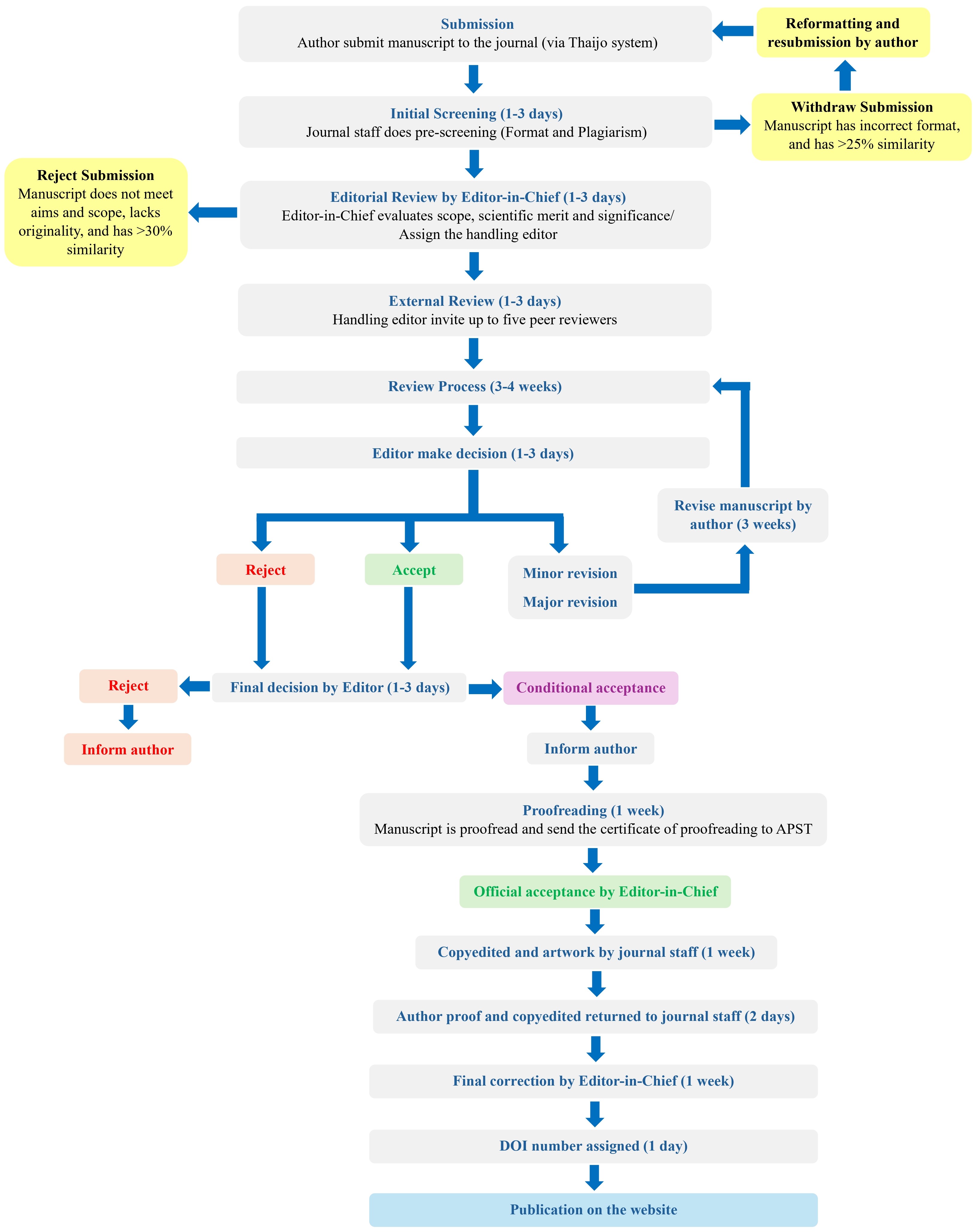Peer Review Process
APST is committed to maintaining high academic integrity and scientific and technology excellence standards through a rigorous peer review process.
The graphical representation below offers a flowchart that elucidates the distinct stages, temporal milestones, and pivotal decision junctures constituting the peer review process for the APST journal:

Peer Review Process
1. Manuscript Submission: Authors submit research/review papers via the Thaijo system.
2. Initial Screening (1-3 days):
2.1 Manuscripts with a plagiarism percentage greater than 25% (excluding the reference list) or where any single source accounts for more than 4% of the content will be withdrawn. Authors of withdrawn manuscripts may revise and resubmit their work. However, manuscripts with a plagiarism percentage exceeding 30% will be rejected immediately without the option to revise and resubmit.
2.2 Manuscript Evaluation Process: APST conducts an initial assessment of each manuscript for proper formatting and innovative content to streamline the review process. Manuscripts that do not meet formatting standards will be returned to authors for revision before proceeding to peer review. Submissions lacking new findings or innovation may be declined without further review. This approach ensures efficient processing and maintains the journal's focus on novel, well-presented research.
3. Editorial Review
Upon submission, manuscripts undergo initial screening by the Editor-in-Chief within 1-3 days. This preliminary evaluation assesses the manuscript's alignment with the journal's scope, adherence to submission standards and style guidelines, proper formatting, and originality. The Editor-in-Chief also conducts a plagiarism check. Authors are notified of the initial decision within this 1-3 days period, determining whether the manuscript proceeds to external review or requires revision/rejection.
4. External Review
Manuscripts that pass initial screening are subjected to a double-blind peer-review process. The handling editor approves suitable reviewers within 1-3 days, after which the manuscript is assigned to 5 peer reviewers. These experts evaluate the work independently, ensuring unbiased assessment. The entire peer-review process typically takes approximately 3-4 weeks to complete, balancing thorough evaluation with timely feedback to authors.
5. Peer Review Assessment
After thorough evaluation, reviewers submit their assessments and recommendations to the editor. Based on this feedback, the editor makes one of four decisions:
- Accept: The manuscript is approved for publication in its current form.
- Minor Revisions: Authors are requested to make minor changes before acceptance.
- Major Revisions: Substantial changes are required, typically necessitating another round of peer review.
- Reject: The manuscript is declined based on reviewer feedback and editorial assessment.
The editor communicates this decision to the authors along with consolidated feedback to guide any necessary revisions or to explain the rationale for rejection.
6. Revision Process
Authors receiving revision requests have approximately 3 weeks to resubmit their revised manuscripts. The editor then reviews the revisions and considers reviewers' feedback, communicating the decision to authors within 1-3 days thereafter. Manuscripts requiring major revisions undergo a second round of review by the original reviewers to ensure adequate addressing of feedback, while minor revisions may not necessitate additional peer review. This process balances thorough evaluation with efficient publication timelines, and authors are encouraged to address all reviewer comments comprehensively to expedite the final decision.
7. Final Decision
The editor evaluates revised manuscripts to ensure all concerns have been adequately addressed. If both editors and reviewers are satisfied, the manuscript advances to the final publication stages . However, manuscripts may still be rejected post-revision if authors fail to sufficiently address reviewer comments. The Editor-in-Chief holds ultimate authority on manuscript acceptance or rejection, maintaining the journal's commitment to publishing only high-quality research. This final assessment ensures that all published work meets the journal's rigorous standards for scientific merit and contribution to the field. This process takes approximately 1-3 days.
8. Acceptance and Publication Preparation
Before official acceptance by the Editor-in-Chief, the manuscript must be proofread by a native English speaker or professional English editing service. Authors are required to submit a proofreading certificate along with the proofread version of their manuscript to the journal within 1 week of receiving conditional acceptance. Once these requirements are met and verified, authors receive an official acceptance letter. They then complete any remaining publication formalities. The manuscript enters the production phase, undergoing final copyediting, language refinement, and formatting adjustments, typically. This comprehensive process ensures that all published work meets the journal's high standards for language quality, clarity, and presentation prior to publication.
9. Proofreading and Online Publication
After acceptance, manuscripts undergo copyediting and formatting to align with the journal's style, which takes about 1 week. After that, the coordinator sends the resulting PDF proof to the associated author for confirmation and replies to the journal within 2 days. Once the author confirms the proof, the Editor-in-Chief conducts a final check and approves it for publication, which takes about 1 week. The manuscript is then assigned a Digital Object Identifier (DOI) number, issue, volume, and year. Finally, the article is uploaded to the journal's website as part of the current issue, making it accessible to readers and researchers worldwide.

